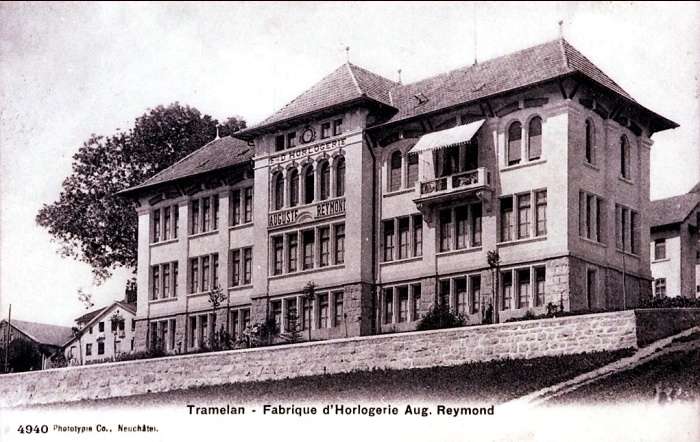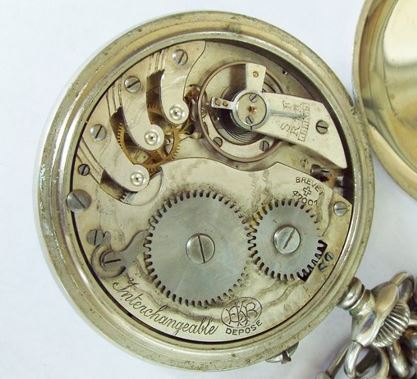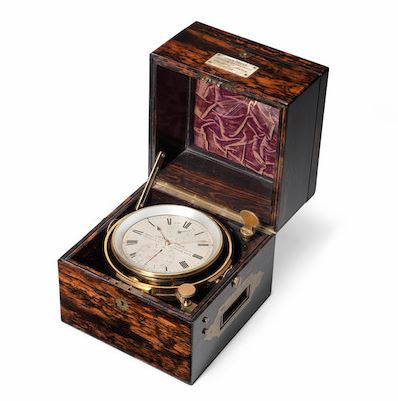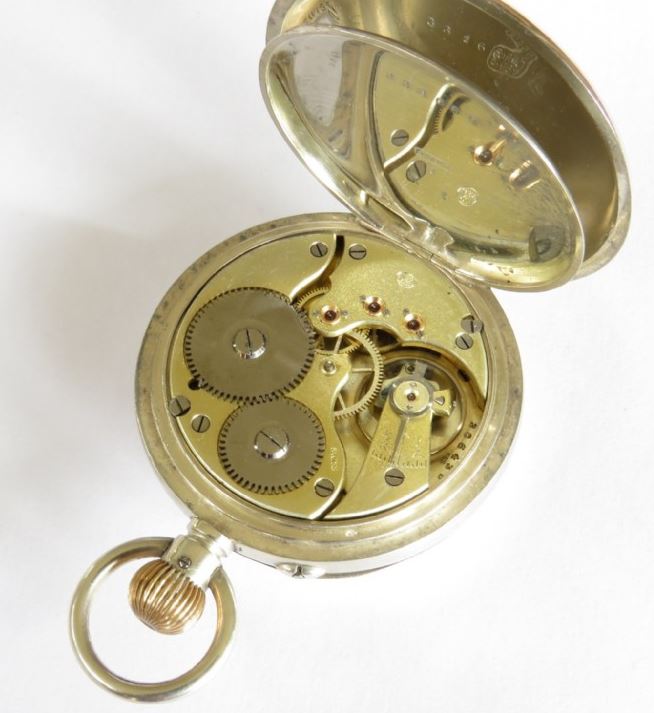This page is for lesser-known watchmakers of antique timepieces where there isn’t enough information to justify a complete page. Some of the information here has been pieced together from unsourced comments in online forums. I try and cross reference as much as possible, but I must admit that some of this is educated guesswork.
Auguste Huguenin & Fils
Auguste Huguenin (1822 – 1864) was the founder of A. Huguenin & Fils, which he established in 1857 in Le Locle, Switzerland. Le Locle is known as the centre of Swiss watchmaking, with roots dating back to the 1600s. It is situated in the Jura Mountains, a few kilometres from the city of La Chaux-de-Fonds.
A. Huguenin & Fils exhibited watches and chronometers at the International Exhibition in Philadelphia in 1876. The firm registered its name in 1880 as required by the 1879 law with the trademark “A. Huguenin & Sons, Locle” and for chronometers “A. Huguenin & Fils”.
At some point, the company became officially known as A. Huguenin FILS SA and moved its factory to Bienne. I have seen an advertisement from 1957 where the company was celebrating their centenary. The advertisement included a picture of the firm’s small factory. The company was acquired by the American/Swiss watchmaker, Hamilton in 1959.
There is very little information online about Auguste Huguenin & Fils and all of it is unsourced. The examples, of Auguste Huguenin & Fils I have seen online have all been of high quality, typically with gold cases and high jewel counts. They also produced watches with complications such as repeaters and tourbillons. I suspect that the company produced a low volume of high-quality watches.
A. Huguenin & Fils should not be confused with the Swiss firm G. A. Huguenin et Fils which began its journey in 1868 when Fritz Huguenin founded a company together with his brother Guillocheur Albert to decorate high-quality pocket watch cases.
It is also worth noting that some sources state that the founder of A. Huguenin & Fils was Adoplhe Huguenin. However, most sources, including reputable auction houses, list the name as Auguste Huguenin.
Related content
A. Huguenin & Fils pocket watch sale at Bonhams.
Auguste Reymond SA
Auguste Reymond (1872 – 1946) was a Swiss watchmaker who set up a workshop in Tramelan, Switzerland in 1898. Reymond started out in a small rented apartment and employed some local watchmakers. Initially, they must have worked as établisseurs, assembling watches from ébauches or blank movements. In 1906, the company began trading as Auguste Reymond SA or ARSA. The company had also acquired the Val de Joux Watch Co. in Les Bioux in order to produce their own movements.
By 1910, the company had grown to over 100 employees and had outgrown the rented apartment. At this point, ARSA was one of the largest employers in the Tramelan region and had acquired its own buildings. The Val de Joux Watch Co. was sold to Reymond Freres SA and was later to become Valjoux SA, the manufacturer of the Valjoux chronograph movement.
In 1926, ARSA acquired the Unitas Watch Co. factory in Tramelan. The factory was specially converted for the manufacture of raw movements. Unitas joined Ebauches SA in 1932, which later joined ASUAG and became part of the SMH group around 1980.
Product lines
In the 1950s, ASRA became known for two distinct product lines, digital watches with “jumping hours” and “Braille watches” for the visually impaired. In the 1960s, wristwatches with a jumping central second hand were made under the ARSA brand as the ‘Springmaster’ model.
Like many other Swiss watch manufacturers, Auguste Reymond SA was hit hard by the quartz crisis. ASRA managed to survive by producing limited runs of quartz watches. In the 2010s, there was a revival of the company, which saw it return to producing mechanical watches.
Related content
Auguste Reymond SA website.
EKB
Established in Bettlach near Grenchen, Switzerland in 1888 by Eduard Kummer (born 26 March 1845). The Bettlach factory initially made ebauches (blank or rough movements), However, the company soon expanded its range to include finished pocket watches. EKB saw the future of the wristwatch and stopped manufacturing pocket watches in 1914. In the 1920s, EKB was one of the first watchmakers to make waterproof wristwatches. A self-winding watch followed in the 1930s.
In the 1920s, the watchmaking industry in Switzerland was fragmented with many competing watchmakers and falling prices. EKB had severe financial problems and in 1931 the company was acquired by ASUAG. The company was split into two parts: The manufacturing department became part of Ebauche SA and from 1937 known as Ebauches Bettlach. The watch finishing department continued as EKB.
In 1952 the name was changed from EKB to Atlantic Watch Ltd. By the second half of the twentieth century, the company had markets in Eastern Europe, South America, and the Middle East. As of 1989, Atlantic Watch Ltd was acquired by UVB and its primary market was Eastern Europe, particularly Poland. The Atlantic Watch brand was still in operation in 2022.
John Poole (1818-1867)
John Poole established himself as a chronometer maker in 1840. Around 1850, he invented an auxiliary compensation balance which was very simple to make and effective in very cold temperatures. Two screws reduced the movement of the balance arm when it expands in an outward direction. The simplicity allowed easy adjustment and whilst not perfect it did produce some significant timekeeping results. Poole received a Gold Medal in Paris in 1867, the year he died by suicide.
His brother James worked with him, taking over in 1867 and later moving to 33 Spencer Street, Clerkenwell. James continued to display his brother’s name on the dial due to his reputation in the watchmaking industry. J.U. Poole, James’ son, continued the business. There is no known date that the business ceased trading. Poole’s maritime chronometers are of interest to collectors at auctions.
Lemania
Lemania was founded in 1884 by Alfred Lugrin (1858-1920), who had trained at Jaeger-LeCoultre. Initially, the company was known as Lugrin SA. Lugrin received awards and gold medals at exhibitions in Milan in 1906 and in Berne in 1914. Lugrin’s son-in-law Marius Meylan (1892 – c1970), took control of the business upon Lugrin’s death. In 1930, Meylan relocated the factory to the town of L’Orient. It was in L’Orient that the name Lemania was adopted, which is believed to be derived from the nearby Lake Geneva (Lac Léman).
Lemania initially specialised in the production of high-quality movements and chronographs for other watchmakers. Their timekeeping mechanisms gained a reputation for precision and reliability, and they became a prominent supplier to various prestigious watchmakers. Lemania movements were used by notable brands like Omega, Tissot, Patek Philippe, and Breguet, among others.
In 1932, Lemania, Omega and Tissot merged to form the SSIH group. In 1945, Lemania produced military watches for the British armed forces, these were produced according to high standards and later became known as part of the collection called the Dirty Dozen. Lemania produced watch movements for both Tissot and Omega, as well as producing their own branded watches. They were typically of high quality. The most notable movement it produced was that for the original Omega Speedmaster. In 1946, Lemania produced a gold chronograph for Sir Winston Churchill, as a sign of appreciation for his leadership during WW2.
Les Fils De R. Picard
According to genealogical records, Raphael Picard was born in 1810 in Hagenthal-le-Bas, a commune in the Haut-Rhin department in Alsace in north-eastern France. He was the son of Benjamin Wolff Picard (1768-1818), a merchant’s labourer, and Esther Picard, nee Bayerlin (1773-1841). Not much is known about Raphael’s early life. However, at some point, he must have completed a watchmaking apprenticeship because, according to most sources, he started out as a watchmaker. He opened a watchmaking business in La Chaux-de-Fonds, Switzerland, about 100km from his home town in France.
La Chaux-de-Fonds is a Swiss city in the canton of Neuchâtel. It is located in the Jura mountains at an altitude of 1000m, a few kilometres south of the French border. The city was founded in 1656. The city’s prosperity is mainly due to its association with the watchmaking industry. Picard started his business with the intention of producing high-quality Swiss made watches at affordable prices.
In 1882, Picard’s sons Edmond, Gabriel and Armand took control of the business. Raphael Picard died in 1884, and soon after the company became known as Les Fils De R. Picard (The Sons of R. Picard). In 1895, the brand was rewarded with a gold medal at the national exhibition in Bordeaux. Further medals were won for a similar exhibition in Paris in 1896. Although I don’t know what these medals were awarded for, I have seen them engraved on Picard pocket watch case backs.
Quality timepieces
I can’t comment on the affordability of the watches from Les Fils De R. Picard, but there is certainly quality. Many of the watches I have seen for sale come with high jewel counts, complications and expensive case material. Examples of the complications include repeaters, chronographs calendars and moon phases. The movements also included enhancements such as cut bi-metallic compensation balances, Breguet overcoil hairsprings and nickel plating.
In 1911, the company registered the brand name Invicta (meaning invincible in Latin). The company’s most well-known brands were “Fils De R.Picard & Co Chaux De Fonds” and Invicta, under which it continued to produce watches through to the 1970s. Like many Swiss watch manufacturers, the company did not survive the quartz crisis of the 1970s. Les Fils De R. Picard should not be confused with Th Picard La Chaux De Fonds, founded in 1892 by Theodore Picard. He died in 1904 and the company continued under the name of Th Picard Fils.
Moeris
Julius Frederic Jeanneret of Saint Imier, Switzerland, had started a watchmaking business in 1866. The company became known as Jeanneret & Fils, when Julius’s son, Albert joined the business. The company received several awards, including an honourable mention at the Exposition of the Horlogerie in La Chaux-de-Fonds in 1881. In 1883, Fritz Moeri and Albert Jeanneret started a separate business, operating as Moeri et Jeanneret. The company became a high-volume producer of high-quality pocket watches. In addition, wristwatches and chronographs were manufactured. In 1899, Albert Jeanneret died and the company was dissolved, probably due to problems with the widow of Jeanneret, who had taken an active part in the business. Fritz Moeri began his own watchmaking business, Fritz Moeri SA. (Fabrique des Montres SA Moeris).
Brands
Fritz Moeri SA was a typical Swiss company of a good standard, selling watches under the brand name, Moeris. Over the years, Moeri was responsible for various patents and innovations, including a 1904 patent for a calibre 19″ movement, known as the ‘Non-magnetic’. In 1906, Moeri was appointed to the Jury of the contest during the Universal Exhibition in Milan. One of his watches was awarded a medal outside of the main competition. Between 1910 and the 30s Fritz Moeri SA produced a range of brands, including Avon, Belvedere, Cherub, Convenience, CUDOS, Civitas, Darnley, Daswood, Excellence, Excellence, FM, Frimosa, Grand Prix, Guntyme, Maoris, Moeris, Moeris Patent, Odaglas, Replica, Rywood, Sekuer, The Bahadur, The Forms, Tikkini, Timeball and others.
Moeris SA had an excellent reputation and during World War 2, was called upon by the British War Office to supply GSTP (General Service Trade Pattern) watches for the British war effort. At the end of the war, Moeri SA was in a strong position and continued to produce variants of the 19″, 19H and 19J movements. In 1970, Moeris SA was acquired by Tissot becoming the “Moeris Department” within Tissot. Production under the Moeris brand continued until the mid-1980s.
Related content
Moeris at Watch Wiki
P. A. Guye
P. & A. Guye was a watchmaking company established in London in 1856. The firm was founded by the Swiss brothers Philippe Guye (1828-1894) and Auguste Guye (1835-1893). Philippe remained based in Switzerland, whilst. Auguste migrated to London in 1856 to start the business with his younger brother Fritz.
Initially, the Guye brothers operated as établisseurs in London. An établisseur was responsible for assembling and finishing watches using components sourced from various watchmaking specialists. In the 1860s, P. & A. Guye began selling watches under their own name. However, most of their business was producing watches that were branded for various retailers, one of which is believed to be J W Benson.
In the late 1860s, they started producing in-house movements at their workshop at 13 Northampton Square, Clerkenwell, London. They were one of the first English-based watchmakers to adopt a mechanised manufacturing system similar to those used in America. The company expanded its operations and began manufacturing movement ebauches and parts using machinery at 14 St. Bride Street, Ludgate Hill, London. Despite the modernised manufacturing methods, all finishing, adjusting, and assembly still occurred by hand, following the Swiss tradition of craftsmanship.
The partnership between the three brothers was formally dissolved in 1888. It is most likely that Phillipe broke ties and remained in Switzerland. However, P. A. Guye continued its operations in London. In the early 1890s P. & A. Guye consolidated their facilities and started to work out of 77 Farringdon Road. The company is believed to have continued until the 1930s when it disappeared from existing records.
Recta SA
Antoine Muller and Alcide Vaucher founded a watch factory in Biel, Switzerland in 1897 under the name “Muller & Vaucher, Fabrique d’Horlogerie.” The company was renamed “Recta SA” in 1898 and specialised in producing high-quality pocket watches, including chronometers with a certification from the observatory. In 1902, Recta established its own factory in Biel. Eduard Tièche joined as head of sales in 1905 and remained until 1946. In 1913, the company expanded and built a larger factory. The company was renamed to “Recta SA, Fabrique d’Horlogerie” in 1917.
Recta was known for advertising its watches with the Geneva seal, the quality stamp from the Geneva testing office “Bureau Officiel de l’Etat pour le contrôle facultatif des montres de Genève”. The company also participated in several chronometer competitions held by the Neuchâtel Observatory. In 1915, Recta added compasses to its product line although it continued to make pocket watches and movements. Marchand & Jobin, London. began importing Recta wristwatches to the UK in 1959. Recta ceased making watches in 1984. In 1996, Recta was acquired by Suunto, a Finnish clock and compass manufacturer. Recta now only produces compasses.
Related content
Recta at Ranfft watches.
Rotary
Rotary Watches Ltd was established at La Chaux-de-Fonds, Switzerland by Moise Dreyfuss in 1895. Dreyfuss started the business with the aim of producing high-quality Swiss made watches at reasonable prices. In 1907, Dreyfuss’s sons, Georges and Sylvain, moved to Britain in order to establish an office. This move enhanced the company’s ability to import and distribute watches to a larger customer base so that they could further grow the brand. Britain became the brand’s main source of business.
By 1925, Rotary had developed significantly as a brand in Britain and the company decided to create a logo that would make the brand more recognisable. The logo the company settled on was a winged wheel, which has remained largely unchanged ever since. When the Second World War began, the armed forces needed a watch. There were as many as 22 watchmaking companies commissioned to produce watches following the A.T.P. (Army Trade Pattern) design. Rotary was one of the brands commissioned and as a result, Rotary watches ended up in a huge number of British households. The company is still in operation today.
Stauffer, Son & Co.
The watchmaking company Stauffer, Son & Co. was established in Switzerland in 1830 with an office in Geneva and a factory in La Chaux-de-Fonds. The factory became known as the Atlas factory. Around the mid-1800s they established an office in London, trading under the name Stauffer & Co. By 1860 they were trading as a partnership between Jules Stauffer and Francis Claude at 12 Old Jewry Chambers, London. Stauffer subsequently retired with his place being taken by Charles Nicolet. They were registered as wholesale watch manufacturers and importers. Claude retired in 1874 leaving Nicolet to take control of the firm. The company relocated to 13 Charterhouse Street, Holborn, London in 1887.
In the 1890s the London branch was selling so many watches that the Atlas factory couldn’t keep up with the demand. As a result, Stauffer & Co. started to source watch movements from other Swiss watchmakers including IWC, Patek Philippe, and Fontainemelon. They were one of the largest importers of Swiss watches into England and the British Empire. In the early 20th century, they became known for their high-quality chronographs and split-second sweep second hands that were used extensively at sporting events. The company remained in the control of the Nicolet family trading until perhaps the 1960s. It is not clear what exactly happened to the company in the end.
Trademarks
Stauffer registered a series of trademarks over the years. “S” on a cross (1880). ” S. & Co” with a crown in an oval (1880). “S.S.C.” in a shield (1880). “Stauffer Chaux de Fonds” (1880). “S. S. & C.” in a shield (1880). “S. S. & Co” with three triangles (1886). “The ‘Atlas’ Watch” (1892). “STAUFFER Cx-DE-FONDS” in a frame (1895). “Stauffer Fils & Cie, La Chaux-de-Fonds (Suisse)” (1912).
The firm of Stauffer, Son & Co. was a major watchmaker for over a century. However, its history is not well documented. My research took me to a number of forum entries, where information had clearly been cut and pasted from other sources without attribution. The best-consolidated source I found during my research was David Boettcher’s excellent site, Vintage Watch Straps, which I suspect was the source of much of the information I uncovered in the forum entries.
Related content
Stauffer, Son & Co at Vintage Watch Straps.
The British Watch Case Company
The British Watch Case Company (BWCC) was founded in 1905. They were based at 236-240 Pentonville Road, London. They were known for making high-quality cases for many top-end watchmakers including Rolex. The British Watch Case Company were a listed exhibitor in the 1947 British Industries Fair. They were listed as manufacturers of watch cases made from various materials, including gold, gold filled, silver, stainless steel and chrome. They also produced expanding bracelets for wristwatches. The company no longer exists.
The British Watch Case Company was not a watchmaker, they simply made good quality watch cases. However, I have seen their maker’s mark on a number of antique watch cases. They definitely existed but there is no definitive history online. Most of what I have scraped together above has been taken from uncited posts in online forums.
Tissot
Tissot was founded in 1853 by Charles-Félicien Tissot (1804 – 1873) and his son Charles-Émile Tissot (1830 – 1910) in the Swiss municipality of Le Locle, in the Neuchâtel canton of the Jura Mountains area. The pair worked out of a small workshop attached to the family home. Initially, they worked as comptoirs or watch finishers, assembling watches with components sourced from local manufacturers. This was known as the établissage system whereby they purchased ebauches (blank movements) and assembled the watches. Charles-Félicien worked as a casemaker and Charles-Émile the watchmaker. Together, they assembled pocket watches, specialising in those with gold or silver cases.
Charles-Emile Tissot toured Russia in 1858 and succeeded in securing a market for their savonnette pocket watches across the Russian Empire. In 1865, the company changed its name for the first time to Tissot & Fils. The company began to produce their own movements for the first time in 1915, which included wristwatches. In 1917, during WW1, the company changed its name again to Tissot & Fils SA. Tissot merged with watch company Omega SA in 1930, forming SSIH (Société Suisse pour l’Industrie Horlogère). Despite the merger, Tissot and Omega maintained separate brand identities and continued producing watches under their respective names.
I have never seen a genuine antique pocket watch from Tissot listed on any of my preferred suppliers. I can only imagine that this is because their focus was on the Russian market up until the Russian Revolution in 1917.
Related content
“A LOOK BACK AT TISSOT.” Montres Publiques.
Zodiac
The Zodiac watch company was founded by Ariste Calame (1839-1917) in 1882 in the town of Le Locle, Switzerland. Calame was the son of a watchmaker and wanted to follow in his father’s footsteps. He set up his own watch workshop where he focused on creating high quality timepieces. Calame’s son, Louis Ariste Calame (1875 – 1955), was sent to watchmaking school and took over the company in 1895 when his father retired. At this point, the company became known as Fils de Ariste Calame. In 1901, the company registered the name Zodiac and began trading as Montres Zodiac SA. Zodiac was best known for its Sea Wolf range on dive watch which was introduced in 1953. The Sea Wolf was marketed to the masses as the world’s first purpose-built “dive watch”.
Related content
Zodiac at Mikrolisk



